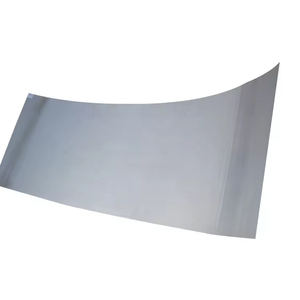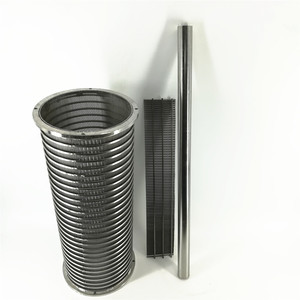
All categories
Featured selections
Trade Assurance
Buyer Central
Help Center
Get the app
Become a supplier

(1105 products available)
























A parabolic screen filter, also known as a basket or strainer filter, comes in many variations. Here are some popular types:
Vertical filter
A vertical parabolic screen filter works in an upward flow manner from the bottom to the top. This setup traps debris at the screen's outer surface and allows clean water to exit through the central collection pipe. A key advantage of a vertical filter is the gravitational force working on filtered debris, which allows it to self-clean. Since the detritus moves downward, there is usually less manual-cleaning demand. A typical application for a vertical filter is for water use in commercial landscapes.
Horizontal filter
A horizontal parabolic screen filter has a flow direction perpendicular to its screen component. Filtrate water passes through the outer surface and flows into a central drain in a horizontal line or parallel to the ground. It is better to use a horizontal filter in situations where there is limited filter height but sufficient width. This type of filter is useful for irrigation, industrial, and municipal water systems. Under normal operating conditions, a backwash mechanism cleans the silt and sediment that has accumulated inside the filter.
Basket filter
A basket filter consists of a woven wire mesh. It is typically circular and housed in a cylindrical filter body. The unfiltered liquid enters the inside of the basket from the outside and then exits the pipeline from the pipeline port after the solid contaminants are caught inside the basket. The solid material can then be disposed of by taking the filter element out of the body or cleaning it manually.
Strainer filter
This filter type is often used for swimming pools, spa pools, and aquaculture. The strainer filter has finer filtration that can trap smaller particles. It is also designed to make backwashing simpler, allowing more frequent maintenance of the filter component.
Parabolic filters are made in different sizes to fit various machines and filtering needs. Usually, the size ranges from a small 50 cm (20 inches) for low-volume workshops to bigger 120 cm (48 inches) for more extensive industrial use. Choosing the right-size filter means it'll work well with the machine and filter enough liquid.
This type of screen is measured in mesh sizes, which shows how many threads are in an inch. Parabolic filters usually have mesh sizes of 20 to 200. The smaller the mesh size, the more threads there are, and the finer particles it can capture. For example, a 20 mesh would let larger particles pass through, while a 200 mesh would trap even tiny particles. The right mesh size should be chosen based on what sort of contaminants need to be removed from the liquid.
The screens are made of strong and long-lasting materials that can withstand regular use and different types of liquids. Stainless Steel is often used since it resists rust and is easy to clean. Some filters may use Polypropylene because it's lightweight, chemically resistant, and has good filtering capabilities. Both materials ensure the filters remain effective and maintain product integrity over time.
Like all filters, parabolic screen filters need to be cared for regularly to make sure they keep working well. One essential maintenance step is to clean the filters frequently, which stops dirt from building up and clogging the mesh. Cleaning can be done by back-flushing the filter with clean water to remove trapped particles.
For more thorough maintenance, it's necessary to inspect the filters regularly. This helps detect any damage like tears in the mesh or loose filter material. Quick repairs should be made on finding any defects to avoid allowing contaminants through. If the damage is severe, replacing the whole filter is a good idea.
It's also essential to track how much water each parabolic screen filter has processed. Setting a max limit based on the type of filter helps maintain its effectiveness. Screens should be replaced after reaching their limit to maintain operating standards. Following these simple maintenance tips will ensure that parabolic filters continue doing their filtering job correctly for a very long time.
These filters are used in diverse industries where the quality of fluids and substances is paramount. Here are some applications where parabolic screens are employed.
Water Treatment Facilities
In wastewater treatment facilities, the parabolic screen filter is an essential component. It is used at the inlet of the filter plant to remove large contaminants such as leaves, plastic, and fish before the water undergoes advanced processing with various chemical additives and treatments.
Food and Beverage Processing Plants
In the food and beverage industry, parabolic screen filters are widely used. They effectively remove pulp and other unwanted materials during fruit and vegetable juicing and processing, ensuring the final beverages are of high quality and free from undesirable substances.
Petroleum Industry
In the petroleum industry, parabolic screen filters serve a crucial purpose. They are employed during oil refining processes to remove solid contaminants and impurities from crude oil, ensuring a higher quality of the refined product.
Plastic and Polymer Manufacturing
In the field of plastic and polymer manufacturing, parabolic screen filters play a vital role. They are used during extrusion processes to eliminate any unmelted polymer particles, carbon black, and other contaminants, ensuring the purity and quality of the materials used in production.
Textile Industry
Within the textile industry, parabolic screen filters are indispensable. They are utilized to remove impurities and foreign substances present in the dyeing and finishing chemicals, helping to maintain the integrity and quality of the dyed and processed textiles.
Chemical Manufacturing
In chemical manufacturing, parabolic screen filters are widely used. They are employed to separate and remove solid impurities from various chemical products during the manufacturing process, ensuring the purity and quality of the final chemical products.
When buying screens, it is essential to look beyond the surface and consider a few factors to select the right type for the filtration task or application. First, buyers should understand the specific use case and not just the general application. For example, well-informed buyers will know that using a parabolic screen filter for well water or industrial waste water will have different requirements in terms of materials, mesh size, durability, and extraction of filtered debris.
Next, buyers should consider the material. The common materials, galvanized steel, stainless steel, and plastic, will have different lifespans and capabilities in high-pressure scenarios. Buyers should also consider the mesh size, which will determine the size of particles that the screen will capture. A finer mesh will filter out more particles, but it will also clog faster and require more frequent cleaning. The expected volume of liquid that will pass through the filter, the type of particles in the liquid, and the user's ability to perform maintenance should all influence the chosen mesh size.
Durability is an essential factor. The filter will see much action in industrial scenarios and must be tough enough to stand the pressure. Frequent users will know various filters last different durations, depending on usage and the quality of the filter material. Another essential factor is compatibility. Buyers must measure the tank or pipe dimensions where the screen filter is placed to ensure a perfect fit. The filter must also integrate properly with the flow mechanisms, pumps, valves, and other components in the system. An incongruity will cause leaks and operational inefficiency.
To ensure the supply and demand chain works smoothly, buyers should wear their seller masks and ensure the end user's requirements are met. Do proper research and determine the seller's filtration needs, buying capacity, and usage data. It's also good to learn about the selected filter's installation process. If it's complicated or demanding, the seller may need to provide education or training to the customer's staff. A better understanding of these issues will make for a smooth buying and selling experience.
Q1: How does a parabolic screen filter work?
A1: Parabolic filters are typically employed in vacuum filtering systems. The screen mesh used for parabolic filters can be varied in size, thereby allowing for different types of materials to be filtered. Larger particles will get stuck on the mesh screen and removed from the material while smaller particles and liquids will pass through the mesh and continue on through the filtration system.
Q2: What are Parabolic filters in the oil and gas industry?
A2: Parabolic filters are used to separate solids in the form of parabolic screens in the oil and gas industry. The filter separates unwanted solids from crude oil by using a rotating drum that has a screen mesh with a fixed wedge wire behind it. As the crude oil moves through the screen mesh, the solids get trapped in the screen while the crude oil moves past the conveyor wedge wire, which is then further processed to extract crude oil.
Q3: Are all parabolic filters the same?
A3: There are many types of parabolic filters, such as ceramic parabolic filters, water parabolic filters, and diesel parabolic filters, to name a few. Each kind of parabolic filter is manufactured to take care of very specific filtration needs. Super fine filtration needs will require a completely different kind of filtration system than large-scale filtering for industrial use.
Q4: Does a parabolic screen filter need maintenance?
A4: The parabolic filter's mesh will need cleaning from time to time, depending on its use. It will also need to be checked for any breaks or wear and tear that will impact its filtering capabilities. The filter will be cleaned, repaired, or replaced in an actual functioning system.